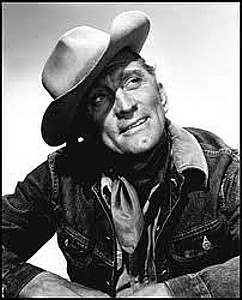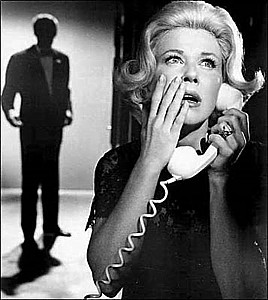DAVID MILLER REMEMBERED
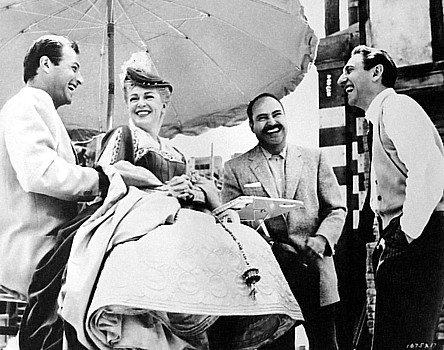 Director DAVID MILLER, right, enjoys a laugh on the set of "Diane," his 1956 historical drama, with, from left, actors LEX BARKER, LANA TURNER and PEDRO ARRMENDARIZ. Barker was not in the film, but was then married to Turner, the film's star. Miller had little to laugh about later, though, considering "Diane" one of his least successful movies. |
He directed dozens of
immortal Hollywood stars
Though his name is rarely mentioned among the giants who directed films in Hollywood's golden years, David Miller is remembered by many as a "director's director," an accomplished pro who guided some of Hollywood's immortal stars in some of their finest films.
A graduate of the short subjects factories the major studios once used as the training grounds for promising directors, Miller is best remembered for four great films made over a span of 20 years--"Flying Tigers," the 1942 action picture that helped make John Wayne America's No. 1 wartime screen hero; "Sudden Fear," the 1952 film noir thriller that earned both Joan Crawford and Jack Palance Oscar nominations; "Midnight Lace" (1960), the psychological suspense picture with singer Doris Day in a rare dramatic role, and "Lonely Are the Brave" (1962), the modern-day western that gave Kirk Douglas one of his most memorable character roles.
Notoriously publicity-shy, Miller eluded me for some time, always rejecting interview requests with the admonition, "I want my films to speak for themselves." But. finally, in June of 1982, he agreed to meet me at the Garden Restaurant of the Century Plaza Hotel in Century City, CA, to talk about his career. He was then 73 and had been retired from filmmaking for several years. The interview oocupied much of the afternoon.
Here are the highlights from that long session together:
BAWDEN: Why this reticence to be interviewed?
MILLER: Always hated personal publicity. I crave anonymity. Here’s a story: A few years back I was at a fancy dress dinner and one of the ladies goes on about her favorite film, "Lonely Are the Brave." And everything she says is rot. I tell her so. “How do you know?” she snaps at me. And I snapped right back, “Because I directed the damned thing!” Everybody was stunned. Nobody knew that and an ominous silence enveloped the dining table for some considerable time. I’ve always been uneasy with celebrity. I want my films judged on merit. I’ve made a few pretty great ones and some very bad stinkers. But I’m totally against the cult of personality.
BAWDEN: How did you start out?
MILLER: As a second assistant cutter (film editor). It’s really the only way to completely understand the business. Very few camera guys cross over to become directors. But cutters–look at David Lean. Eddie Dmytryk, Bobby Wise. I was born in Patterson, New Jersey, and started off as a copy boy at 14 for National Screen Service, which took negatives and screen clippings and made the trailers. Then I went to Columbia as second assistant cutter. We’d work all night. Another team would work all day because Columbia made a lot of movies then. I helped Frank Capra cut "Ladies of Leisure"(1930) and he promoted me until I moved on to MGM.
BAWDEN: At MGM, I understand you specialized in short subjects.
MILLER: It was so exciting many of these kid directors didn’t want to go on to features. I directed a lot of "Crime Does Not Pay" shorts. Then I worked directing Carey Wilson’s miniature histories. The last five years I was there I got an Academy Award nomination yearly. I needed a fresh face, looked out the window and chose this new kid--Spangler Arlington Brugh--who became Bob Taylor. It was his first job. My fellow apprentices and I worked six days a week on shorts. Jack Cummings produced all of them and then came Jack Chertok, who later produced the TV series "Private Secretary."
BAWDEN: When did MGM's studio chief, Louis B. Mayer, spot your work?
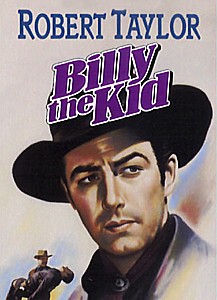
MILLER: He watched all the shorts, looking for new talent. We used a lovely girl, Laraine Day, in one and LB plopped her into the "Dr. Kildare" series and she became a star. He loved a short I did called "Drink Driving" and called me and said thanks. Another, "The Flag Speaks", made him weep. He offered me "B" directing work but I declined. I just wasn’t interested. Once one got into Bs, it was no escape, never.
BAWDEN: What was your opinion of Mayer, who was a very controversial man?
MILLER: A brilliant man. A terrible man. One crossed him and one was dead. Actors he hated? He sold their contracts to other studios. Directors he disliked were shunted into B movies. He was really the father of the factory system, which he put in place in 1924 with the merger of Metro and Goldwyn studios. It worked this way: Produce your own movies. Own your own movie theaters. In this case, MGM was owned by Loews Inc. (the theatre chain). That way you could assure a steady stream of product and keep all the talent under exclusive control. And it worked until about 1950 when TV came along and the huge movie attendance figures began to dip.
Mayer always had a plan. I’d be summoned to his office and he’d brief me on my progress in shorts. He had a grand design that sometime in the early 1940s I’d get transferred to features. He said the original MGM directors–Clarence Brown, Robert Z. Leonard, Richard Thorpe–had started way back in silents and were aging. New blood was needed. He’d hired (Frank) Borzage, (Mervyn) LeRoy, (Victor) Fleming from the competition but it wasn’t enough. He needed fresh blood and he was going to get it from the shorts. That’s why I was honing my skills there and so were George Sidney, Fred Zinnemann and even Jules Dassin. We’d be top of the line in 10 years, he said. And then a funny little accident called World War II came along and upset all his carefully constructed plans.
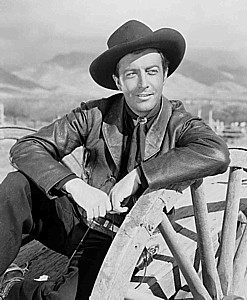
ROBERT TAYLOR was the star of David Miller's first feature film as a director, the big budget Technicolor MGM western "Billy the Kid." The studio was interested in forging a more masculine image for Taylor, but Miller considered him "a mama's boy."
BAWDEN: How did you get for first feature assignment, "Billy the Kid"?
MILLER: Very late one night–I was living in Westwood at the time–L.B. phones me all agitated. And he says, “I’ve got a big western for you, 'Billy the Kid.' Report tomorrow morning sharp. You’re taking over.” What was I supposed to say? I mumbled “Thanks” and couldn’t sleep all night. The original director was Frank Borzage, who was in his last year with MGM. He’d already directed Bob Taylor in "Three Comrades" and "Flight Command," but this time tempers had flared on location in Arizona. Frank later told me he faked an illness to get out of it because Bob was very demanding. The studio was trying to make him a more masculine star –no more women’s pictures for him–and Borzage just found him too stolid to work with.
Frank had shot for weeks on Arizona locations. About a third was finished. Back on the Metro backlot the rest was going to be done. Mayer told me he’d decided to replace Maureen O’Sullivan with Mary Howard. He said Maureen had hit 30 and was looking too leathery and he wanted Bob paired with a more compliant and younger girl. I had a wonderful cast: Brian Donlevy, Lon Chaney Jr., Gene Lockhart. Bob was determined to be more masculine, but he really was a mama’s boy at heart. He had to fake nastiness and it showed. I used the script Frank had approved complete with his notes. I got through it fast and efficiently without any major bloopers. It made a bundle for MGM because Bob was red hot at the time.
Then one day I was dining at the Brown Derby and (director) King Vidor comes over and puts his hand on my shoulder and compliments me. What an honor! He’d made the original ("Billy the Kid") in 1931 with Johnny Mack Brown. He said he’d enjoyed my Technicolor version. I wouldn’t compare my version to his, but I was forever grateful for such praise.
BAWDEN: Then what happened?
MILLER: Mr. Mayer gave me a little movie to make called "Sunday Punch" with a shooting schedule of 14 days. A funny little thing featuring such up ‘n comers as Bill Lundigan, Dan Dailey, Jean Rogers and such character types as Connie Gilchrist, Sam Levene, J. Carrol Naish, set in a boarding house filled with wannabee boxers. Somebody called it a male "Stage Door" thing. Paul Vogel was the cameraman and he lit our sets magicially. Told me he stole all the ideas from "Citizen Kane." Dan had this horrible fake Norwegian accent. Thinking about it still makes me laugh. Any time we had a dull moment, I’d plop in Rags Ragland and Leo Gorcey.
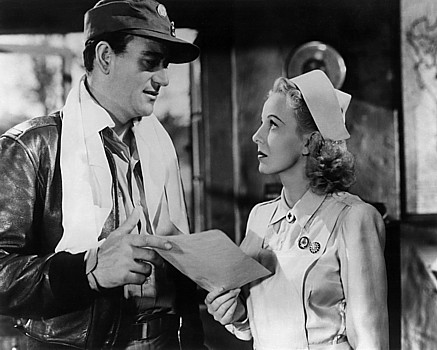
"Flying Tigers"
(1942), a film
Miller made on
loanout to
Republic studios.
Then Mayer loaned me and (actor) John Carroll out to Republic because he needed Duke Wayne (who was under contract to Republic) for that stinker "Reunion in France." We sat around on salary until the Duke was ready to make "Flying Tigers." I found him a quiet, observant guy. His college major had been Latin! Hated not being able to be in the war but he had a demanding wife and little kids. Anna Lee was the British nurse, Paul Kelly was a has-been flyer and for a bit as a bereaved widow I used Mae Clarke and she hit a homer, She was so wonderful. I loved working at Republic. They didn’t sit around for days, as at MGM, before making a shot. I think we captured the devil-may-care attitude of the American flyers in China before war was actually declared. Duke did all his fighting on the backlot. I hear Jack Ford used to really razz him about this. I’m glad I knew him as a human being before he became today’s right wing icon.
BAWDEN: After the war you went back to MGM?
MILLER: Mayer tore up my old contract. He’d just lost Jimmy Stewart and he was fearful of mass defections. Got my first assignment for what turned out to be "Green Dolphin Street." I remember one afternoon the scripters and crew sat around wondering how we could portray Lana Turner as a virgin. And there was a huge confab about what cup size her padded bra should be. Couldn’t take it. “Give her two left breasts!” I shouted. I just stood up and walked out, right out of the studio. Never looked back. I’d had it. I needed more time to adjust you see.
BAWDEN: When you were ready to work again, you went to United Artists?
MILLER: In 1949. Needed money by then. Ben Hecht had written a lovely story called "Diamonds in the Sidewalk" as a solo vehicle for Harpo Marx. You must remember, by 1949 the Marx Brothers were considered quite passe. But I thought this was charming and filmable and the producer Lester Cowan got financing for a small budgeted affair. Then Harpo asked if we could include Chico who had gambled away everything on horses. Then Groucho heard about it and demanded to be included. We had a Marx Brothers movie but the plot was too slender to contend with three egotists. We wanted to take the basic material on the road as the guys had done with "A Night at the Opera." But there were no funds and we had writers who knew nothing about gag construction.
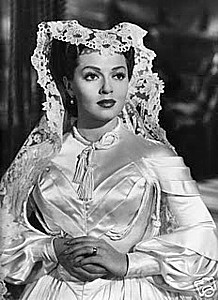 |
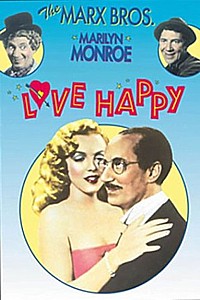 |
Director David Miller wasn't happy with the task of making LANA TURNER, above left, appear virginal in the turgid period melodrama "Green Dolphin Street." He left MGM and ended up directing the Marx Brothers in "Love Happy" (above right), in which Marilyn
Monroe had a small "dumb blonde" part, being chased around a desk by Groucho Marx.
BAWDEN: People see the film today, which was retitled "Love Happy," because it has a very early appearance of Marilyn Monroe.
MILLER: Ilona Massey was our blonde, but we needed a dumb one, too. Marilyn walked in for an interview and Groucho shouted, “You’re hired.” She never laughed at any of his jokes, which meant we could do everything on the first take. He was mightily smitten with her. Johnny Hyde was her agent. She was 23, had dirty fingernails, never washed ,so her neck was dirty. She looked bewildered and that stuck. She just oozed sex appeal. Hyde said he was going to marry her, but he passed from a heart attack. But he was very much in love with his creation.
BAWDEN: Then you went to Paramount for Bing Crosby's film "Top O’ the Morning" (1949)?
MILLER: That was entirely Groucho. He talked me up to Bing Crosby, who had veto power over his directors. In fact, his company, Bing Crosby Productions, made it for Paramount. And he said I was on, after a short interview. This one was the third in a series starring Bing Crosby and Barry Fitzgerald. Now I’m going to tel: These two barely tolerated each other. Barry would wander far from the script and he mugged atrociously. Bing was a one-take kind of guy but Barry tested his patience. Bing’s in Ireland hunting down the Blarney Stone. Not quite in the category of "The Quiet Man" and our Irish village was backlot stuff. Ann Blyth was the love interest but she was 25 years Bing’s junior and looked more like his daughter. Hume Cronyn was in it. I used every Irish actor I could find in Hollywood. It was a crowd pleaser but not much more.
BAWDEN: Then came "Our Very Own" (1950) with Ann Blyth again, but this time at Goldwyn studios.
MILLER: The old boy (Samuel Goldwyn) was interfering, wandering around the set and causing mischief. But he wanted a feel-good story about adoption and for Ann’s beau we had Farley Granger, then at the peak of his bobby soxer appeal. Jane Wyatt was the adoptive mother, but Ann Dvorak walked away with her scenes as the slatternly real mother. I felt the script by F. Hugh Herbert sugarcoated everything. When Ann comes home from meeting the real mom, I argued Donald Cook as her adoptive father would be so angry he’d strike her. Goldwyn rushed on the set shouting, “No violence in my picture!” I had already shot the rehearsal to keep him at bay and when Don struck Ann her head bobbed and she ran up the stairs in tears. Goldwyn watched in dour silence at the dailies the next morning, then commanded me NOT to shoot it his way. I also got a $10,000 bonus at shooting’s end. But I still feel it should have been even tougher.
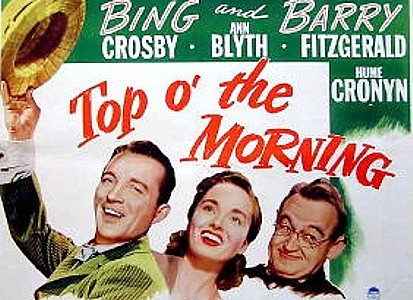
revealed that Bing
Crosby and frequent
co-star Barry Fitzgerald didn't really get along so well while he was directing them in "Top O' the Morning" for Paramount.
BAWDEN: How did you survive working with Joan Crawford as star of "Sudden Fear" (1952)?
MILLER: In one interview years later she said Vince Sherman and I were the only quality directors she had in The Fifties. She demanded total perfection from everyone. She’d arrive in the morning with an entourage and said hello to everyone. Jack Palance told me he really wanted to strangle her. She came on to him but he rebuffed her. He already was in character. (Palance is the villain in the movie.) She knew more about lighting and camera angles than anybody I ever met. She never wasted a moment on the screen. She was a bit tense at first. She’d just left Warners and this was her first independent production. She had a percentage of the take and made over $1 million because this one was a big hit and garnered a third Oscar nomination for her.
Gloria Grahame irritated her to no end–Gloria was 15 years younger and smoking hot. That’s why. I gave a kid named Touch Connors his first lead–today he’s TV’s "Mannix" (as Mike Connors) . We shot almost everything in San Francisco and at the end Joan is running in her heels up and down the streets of San Francisco as Palance in his car tries to run her down. Boy, did Joan work up a sweat. She loved that challenge. I can still hear the clickity clack of her heels on the brick pavements.
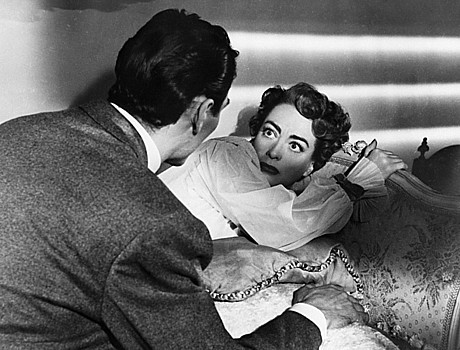
a scene from
"Sudden Fear."
In real life,
Crawford made
a play for
Palance, but didn't get very far.
BAWDEN: Next you scared Ginger Rogers half to death in "Twist of Fate "(1954).
MILLER: I got a reputation for scaring ladies of a certain age. This one was made by British Lion using Ginger Rogers as bait to get into the American market. But we had a top cast of Brits backing her up: Stanley Baker, Coral Browne, Herbert Lom. Ging met a young hunk on the set named Jacques Bergerac and married him! She was 43 and he was 28 and there were a lot of jokes made on set at her expense. I was so surprised my British crew had such a collective inferiority complex. The photography was fine, the sets first rate but still they acted like Ging and I were from another world. The movie is a cool, efficient thriller, shot almost entirely on the French Riviera. The budget was small, so it was black and white, which we used to good effect in making Ging look a lot younger than she was.
BAWDEN: Then you went back to MGM for "Diane" (1956).
MILLER: There was no MGM by 1955-56. Mayer was gone and dying of leukemia. Dore Shary (his replacement as studio chief) was about to be fired. MGM got me back with "Diane." If only we had stayed true to the book and the times. I think it was Lana Turner’s last for MGM. She’d started out there in 1938. And now at 35 she was a scared woman, facing an uncertain movie future. Or so MGM thought –she then waltzed over to 20th, made "Peyton Place" and got her first ever Oscar nomination.
I mean, I tried. Christoper Isherwood co-wrote it. But MGM laid on on a ton of opulence that destroyed all intimacy. It simply did not look genuine at all. Walter Plunkett did the designs by way of Vegas, it was all so anachronistic. For one thing. no audience knew anything about Diane de Poitiers or even cared. It was my salute to 16th Century France as recreated on the playing fields of Culver City. One problem was Lana’s leading man. Yes, it was Roger Moore, so young and pretty that Lana became jealous of his close ups! I think Marisa Pavan got it very right as Catherine de Medici. I think I got it very wrong. My direction was plodding. This one is so boring. A little camp might have lightened the proceedings.
BAWDEN: Then you were back with Joan Crawford at Columbia in "The Story of Esther Costello" (1957).
MILLER: It played as "The Golden Virgin" in some European markets! Joan’s last as a leading lady. She had married Alfred Steele, a Pepsi vice president, and didn’t act for more than two years. In the airport scenes you can see Pepsi dispensing machines –one of the first instances of product placement. She was 53 at the time and she hated the whole idea of what she termed “foreign productions”. So, this one was shot at Harry Cohn’s insistence in Ireland and England. Nicholas Monsarrat (who wrote the original novel) did the bulk of the screenplay. It was quite race stuff for 1957. Joan adopts an Irish orphan who turns out to be deaf. And blind. Then sleazy promoters take over. It was a real indictment of the media. It all depends on Heather Sears, the truly remarkable girl who played Esther. She was equally fine in "Room at the Top." Joan went all out and demanded that ending where she kills herself and Rosanno Brazzi, who had raped the girl. Strong stuff, but did you expect subtlety in a Crawford melo?
BAWDEN: Why did you get the comedy "Happy Anniversary" (1959)?
MILLER: I wanted to prove I could do comedy. I couldn’t. Poor Mitzi Gaynor was trying to prove she could make people laugh. She couldn’t. And they were not making her kind of musicals any more. David Niven was an expert at this kind of thing, which was a reasonably successful stage comedy. It’s very Fifties but nobody ever mentions it today. I mean the little girl in it is Patty Duke. That’s a long time ago.
BAWDEN: Then you got a chance to scare Doris Day in "Midnight Lace" (1960).
MILLER: Doris still blames me for that one. Ivan Goff and Ben Roberts wrote it from their stage play. They later did "Flipper." As filming progressed, Doris got more and more in a frazzle. She was haunted by memories of her second husband beating her up. Then she did a scene and really fainted and Ross Hunter, our producer, had to shut down filming for days to let her recover. At the conclusion, she told her husband she’d never do another drama. And she hasn’t. As usual with Ross’s movies, we packed it with familiar faces: Myrna Loy, Herbert Marshall, Roddy McDowall, and we got Rex Harrison at a fire sale price. He was trying to stir up interest in Hollywood by proving he could carry a movie. That’s because "My Fair Lady" was about to be cast and he told me he feared Cary Grant would get it. He was furious at Doris’s hysteria scene. He thought she was hogging the camera! It played to great box office returns. A friend saw it on TV recently and claimed it was an un-credited remake of "Gaslight." Never thought of that before but now that I think about it: yes, he’s right!
BAWDEN: Then you did "Back Street" (1961) with Susan Hayward, also for Ross Hunter.
MILLER: First, I told Ross there’ll be no back street in my movie. Because times had changed. Women like Rae did not have to cower in the background anymore. We made her a fabulously successful designer with a string of great apartments. And a wacky boss in Reggie Gardiner. As her paramour I was forced to use John Gavin, who’d also been in "Midnight Lace." Great guy, but lackluster as an actor. Susie was a bit defensive about the age difference . She was 43 and John 29. The first day on set for costume fittings she walks right over to Vera Miles and says, “Ten years ago I would have killed for your part. You’ll make a magnificent bitch!” And Vera did! We built up the wife’s part–she’s only glimpsed in the other versions—and Vera played her as a roaring drunk to show Gavin couldn’t leave her or she’d keep the children. And it would ruin his political ambitions. We made him seem Kennedyesque. Jean Louis’s creations were to die for. We knew our audience. Theaters were filled with housewives every afternoon.
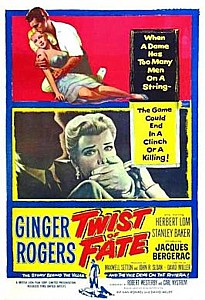 |
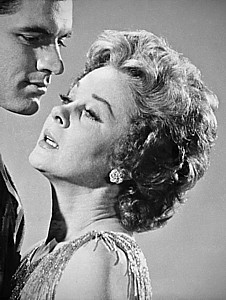 |
David Miller's "Twist of Fate" (above left) gave a strong film noir role to GINGER ROGERS.
SUSAN HAYWARD (above right) snak her teeth into the melodrama of "Back Street," with co-star John Gavin.
I asked for Stanley Cortez for photography. I needed a certain gauzy sentimentality for the early scenes shot during World War II to contrast with the high style of the Sixties--and I got it. At the end, after the parents get killed, the two kids go out to Rae’s country estate to beg for her friendship. Try watching that without tearing up. I dare you! The critics got onto us because Susie didn’t suffer enough. But she didn’t have to!
BAWDEN: "Lonely Are the Brave" (1962) is now considered one of the best westerns.
MILLER: Universal had no confidence in it and buried it. They owed Kirk Douglas a picture after "Spartacus" but nobody got behind it. When the rave reviews flowed in, the suits in the black tower were furious. Today it would get an art house release. Then it opened to empty seats in the big old movie palaces. By the way, despite the arduous schedule and locations, I came in one hour ahead of schedule. I was warned about Kirk Douglas, but he really got into his role. For once he did not try to bully the director. It’s all in the script and Dalton Trumbo delivered a beaut. Kirk recommended him and we grabbed at that. But Kirk went all out in his portrayal. He’s front and center, you just gotta believe in this character. We also had Carroll O’Connor, Walter Matthau, George Kennedy and, best of all, Gena Rowlands as the best friend’s wife. Steven Spielberg loves this movie almost as much as I do. For once everything just came together.
BAWDEM: What about "Captain Newman, M.D." (1963)?
MILLER: Well, what about it? A fine vehicle for Gregory Peck. And the first film to truly probe the psychological scars of warfare. Don’t forget Vietnam was just starting to unfold. MCA was really scared of this one. Peck loved his part because he craved respectability and was very wary of changing his image at all. Tony Curtis as the male intern on the ward really recognized the humor of the situations and ran with them. It was hard getting that tone–the irony, the fun, the sadness. Bobby Darin as one of the inmates was so good he got a supporting Oscar nomination. Russell Metty was the photographer and I told him not to go pretty, I wanted the starkness of the hospital. I cast for talent: Jane Withers, Larry Storch, Eddie Albert, Bob Duvall, they all have their turns at bat. Angie Dickinson was great as the soul mate, great for that period but I might cast differently if doing it today.
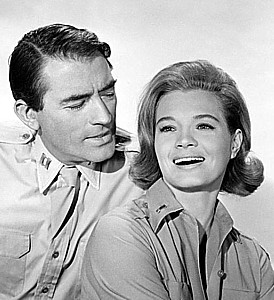
DICKINSON co-starred in
one of MIller's last big films,
"Captain Newman, M.D." (1963).
BAWDEN: Then what happened?
MILLER: The business changed. I didn’t work for five years. Universal even fired Ross Hunter and Doris and Rock moved into TV. Finally, against my better judgment, I did "Hammerhead" (1968), a very bad spy thingy with Vince Edwards, who had no big screen charisma. Hated it. Then I made "Hail Hero" (1969) with a very young Michael Douglas as a draft dodger and Arthur Kennedy and Teresa Wright as the parents and, of course, the right hated it and it did no business at all. After four more years unemployed I did "Executive Action" (1973) about the Kennedy assassination and on a very tiny budget I think we made the point there was a conspiracy. There really was. Then in 1976 I made "Bittersweet Love" (1976) with Scott Hylands and Meredith Baxter as lovers who discover they are brother and sister. Lana Turner was in it, too, and one day on set she whispers to me, “Did you ever think it would come to this?”
BAWDEN: Then what happened?
MILLER: I brooded, I sat around, then Ross Hunter phoned. He was going into TV and asked me to direct "The Best Place To Be" (1986) about a widow who gets challenged by life. He asked Audrey Hepburn to do it and she refused. I said go for Donna Reed and Ross thought about it and NBC wanted Donna because her TV series was running all over the place even though she hadn’t acted in 13 years. She had a facelift just before we started. And I rounded up a great cast of supporting players: Efrem Zimbalist Jr., Betty White, Mildred Dunnock and we had a huge ratings hit. I tried again with "Love For Rent" (1979) with Annette O’Toole, Rhonda Fleming, Darren McGavin and the numbers were pretty good. And then I did "Goldie and the Boxer" (1979) and "Goldie and the Boxer Go To Hollywood "(1981) with O.J. Simpson, Jack Gilford, Jimmy Gregory, and we had some fun with very light material.
And so far I’ve resisted the temptation to go back to work. But who knows, who really knows?
David Miller never went back t work. He died April 14, 1992, aged 82, in Los Angeles.
by Jim Bawden. This column first posted Feb. 13, 2012.

